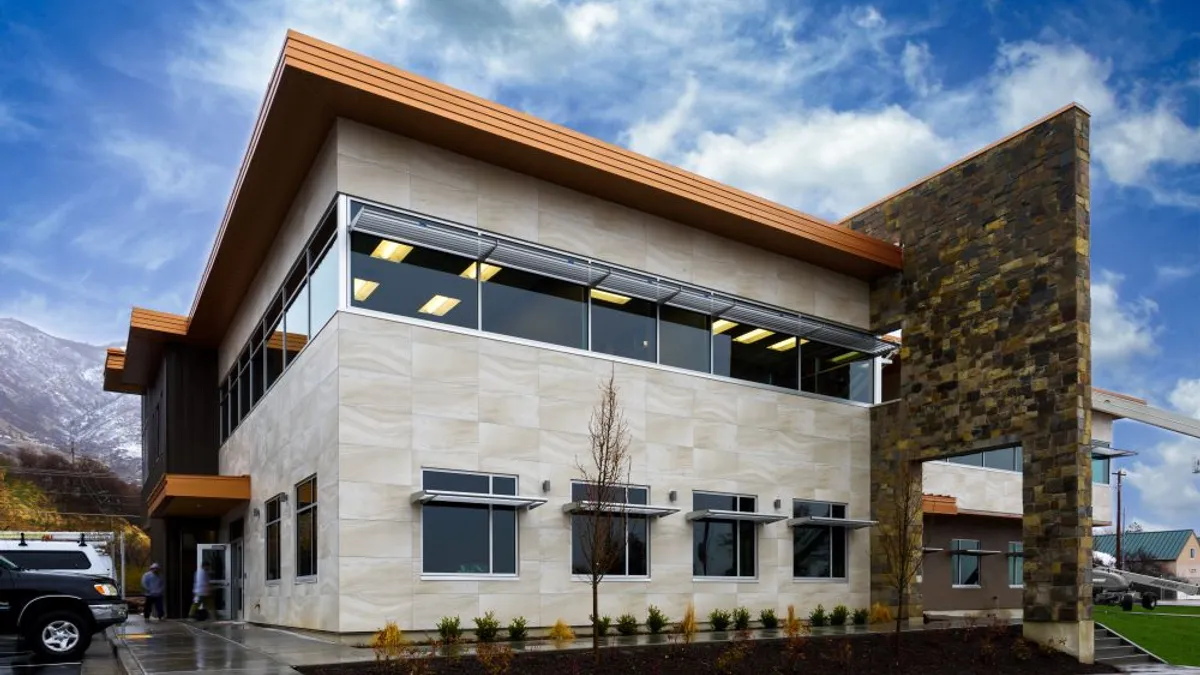We all know the environmental and business reasons why commercial buildings need to become more efficient and low carbon. From sports facilities and airplane hangars to sleek office spaces (and everything in between), commercial structures account for around 20% of the energy consumption in the United States. And the built environment is responsible for 40% of global greenhouse gas emissions.
“Pre-engineered buildings offer creative, economical and very sustainable opportunities,” says Christen Funk, president of Butler Manufacturing, an industry leader in pre-engineered metal solutions.
By reshaping perspectives about how creativity and carbon reduction can exist in harmony, Funk believes the entire construction industry can realize expanded opportunities. “I want architects and builders to think of pre-engineered metal solutions as a different kind of canvas to create their visions on. This is about changing the dynamic to an efficiency mindset supported by design and building freedom.”
That unconventional and cross-functional mindset is so critical to the evolution of the industry that a recent BlueScope Buildings innovation accelerator launched five new pilot programs designed to revolutionize the construction industry.
Dan Kumm, senior director of business insights at BlueScope Buildings states, “Forming partnerships across industries and areas of expertise can unleash more innovative processes and drive greater efficiency throughout construction and the full life-cycle of a building.”
Three distinct approaches are vital to achieve greater energy efficiency in the building process.
1. Track the supply chain to ensure optimized materials
A comprehensive view of the supply chain is essential to ensure the most efficient end product. Kumm emphasizes, “To get a low-carbon solution, you have to get down to supplier-specific knowledge — where the raw material was first sourced and how much embodied carbon was accumulated along the journey to the final product stage."
“The best way for a design team to gain supply chain visibility is to engage suppliers who can track their sub-suppliers, through every step of material sourcing and production,” Kumm advises.
For architects who want to begin having this conversation with suppliers, consider starting with a steel fabricator’s mill test report (MTR).
2. Smart steel solutions reduce carbon emissions
Ryan Hill, president of Varco Pruden Buildings, advocates for transparent collaboration to achieve low carbon output. “We're going to have to actually graduate the construction industry into a realm of transparency and trust, that enables collaboration to deliver a different level of low carbon output.”
Together, architects, engineers and steel producers can achieve aesthetic goals and structural integrity by determining the best product application for their specific project at the outset of the process.
While steel is infinitely recyclable — which is great from a sustainability perspective — Kumm sums up the value of efficient material use: “One of the best things you can do for carbon reduction in a new build is to use less materials.”
Anyone who wants to communicate the impact of smart steel solutions in concrete terms can use the EPA Greenhouse Gas Equivalencies calculator.
3. Collaborate early for efficient design
Early collaboration is pivotal in forming shared goals and delivering low-carbon solutions. “Engaging certain suppliers of key materials way earlier in the process - to help drive that carbon out from day one - is critical,” says Kumm.
Hill agrees that early partnership is essential. “Over the last 10 to 15 years, energy codes have become more stringent, and that trend will likely continue,” Hill explains. “As experts in how steel functions from a structural perspective, we can work with the design team on alternative solutions.”
The bottom line, according to Hill, is about integration. “If the same group handles all functions of a build together, it often speeds up the process and gets the final product to the owner - quicker.”
Efficient steel solutions equal long-term benefits
Today’s smart steel buildings can be as aesthetically appealing as they are strong and energy efficient. Funk agrees, “Steel exteriors might involve higher upfront costs, but ultimately enable savings, enhanced longevity and increased sustainability, thanks to durability.” The potential to combine steel buildings with further eco-friendly options, like solar panels and rainwater collection systems, adds to their appeal. Insulation techniques and deflective roofing commonly used for steel buildings also increase energy cost savings.
“When a project enables optimized teamwork, smart steel solutions and better supply chain insight, the result is more energy-efficient buildings — as well as a healthier planet,” Funk continues. “We all love beautiful design and spaces where people can work, play and connect. As architects, builders and steel producers, we have the same goals, we just get there a bit differently.”










